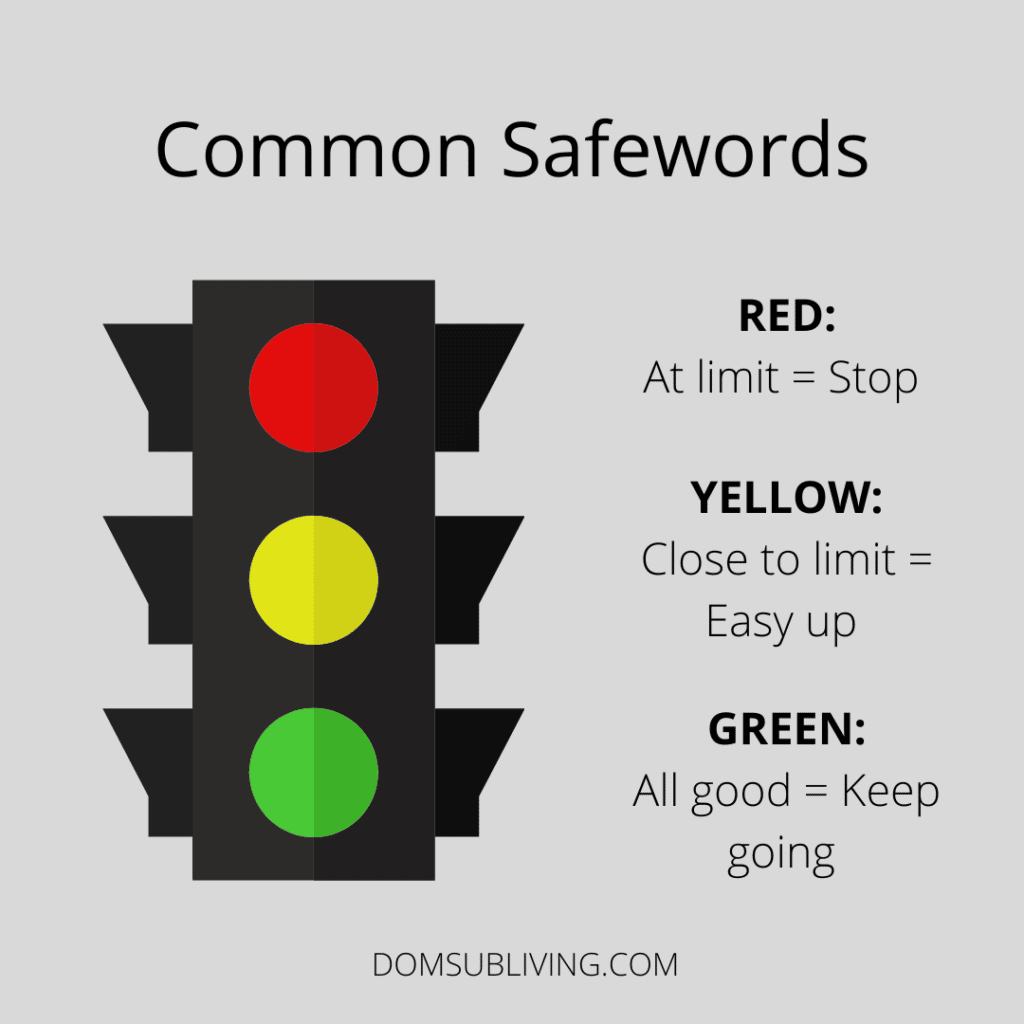6 Effective Safewords BDSM Couples Need With Examples

Ever since Fifty Shades of Grey, the meaning of “safewords” has become more popular. But many people, even in the BDSM community, still don’t know how to pick a safe word or use it correctly. BDSM safewords are codes to communicate when a submissive is at their limit or close to it, and I’ll show you some practical safeword ideas you can use in your next play session.

1. Why “Pineapple” is One of the Good Safewords to Use
By definition, “No” and “Stop” are not safewords. A safeword needs to be something you would not normally say in a play session or scene. That’s why “pineapple” is one of the best safewords anyone can use. If you pick a word that is too common, the meaning can become unclear.
Why Fifty Shades of Grey Used “Red” & “Yellow”
There’s a good reason why Fifty Shades of Grey chose those two examples. The most popular safeword is “Red,” meaning the sub cannot tolerate further demands, and the Dom’s actions cease immediately and completely. “Yellow” signals to the Dom that the sub is close to their endurance limit.
Red and Yellow are my favorite and the ones I use with my Dom, but we also have an alternative. Back when we were a vanilla BDSM couple but also did kinky things, I would use his middle name as a code. I had used it for so long that it was still a habit, so we decided to keep it.
When you are in the middle of a very intense situation, it is somewhat of a knee-jerk reaction to blurt out the first thing that comes to mind. So pick a safeword(s) you feel comfortable with.
Here’s a brief list of popular safeword ideas:
- Apple
- Red
- Pineapple
- Dom’s middle name
- Banana
- Yellow
- Safeword
- Mercy
- Oklahoma
2. Safewords Help Establish BDSM Limits & Boundaries
If a couple is exploring something new like anal play, safewords can help guide the Dom as to what is acceptable and too far. One of the roles of a good Dom is to push the boundaries of their sub a little, to see what they are and aren’t OK with.
To use safewords this way, a Dom can check in with the sub during a scene and ask, “What color?” The sub can then replay “Red,” “Yellow,” or even “Green” to indicate that they want to go further. You could even practice this technique to get a sub comfortable using safewords.
Important Note: Safewords aren’t only for scenes or playtime. Both Doms and subs can use their safeword when any situation puts them at or close to their limit emotionally or mentally or if a boundary is being crossed.
3. Subs Can Abuse Their Safewords Without Meaning To
Let me start by saying that there is nothing wrong with using safewords. Safewords are a sacred part of BDSM for ensuring everyone involved lives a safe BDSM lifestyle; a lifestyle that is safe, sane, and consensual. A sub should never feel guilty when they use them legitimately.
The problem arises when it becomes a way to get out of something they don’t want to do. It can become the vanilla equivalent of saying they have a headache. Besides sexual requests, they may use a safeword when a situation becomes emotionally challenging and they just want a break.
In short, the sub gains control when they use their safeword because they just don’t feel like doing something, ultimately topping from the bottom in a way the sub shouldn’t.

4. You Can Try Getting Rid of Safewords… Maybe
In some Master/slave relationships, there is the concept of Total Power Exchange (TPE), meaning that the slave has relinquished all rights, even the right to a safeword.
If the sub consents to this (and they have to consent) there needs to be complete trust in the Dom’s training to strengthen their control, skills, and knowledge of the sub. This is best for long term, 24/7 relationships.
If you’re not ready for this step, an alternative could be agreeing to forgo safewords during submissive punishments. This has the advantage that a sub is more likely to learn from their punishment or not misbehave, if they know they cannot say a safeword out of it. The Dom would then have total control over the discipline and not the sub.
Another possibility would be not to let the sub use “Red” while being punished, only “Yellow.”

5. You Need Nonverbal Safewords, Too
There are at least eight ways to enjoy bondage, but if choking or gagging is acceptable, agree beforehand on nonverbal safewords like gestures because you won’t be able to talk. This can be a hand signal or placing an item in the sub’s hand that they can drop when they have reached their limit. Attaching a small bell to the hand with a bandage also works well.
The downside is that the sub’s arms and hands would have to be free at all times, and even the most well-trained Dom may not see the sub’s signal during a BDSM scene.
To get around this, my Dom and I agree that my hands and arms are always free during choking, and our “safeword” is that I will tap his body anywhere I can.
Once he feels it, he releases me immediately. Try a practice session before committing to your signal.
6. Subs Can Forget to Use Their Safewords
Sometimes the Dom may make demands of the sub that cannot be met without incurring physical, mental, emotional, spiritual, or other harm, which is when the sub should use their safewords.
However, in that circumstance, the sub may already be distraught because of the severity of the situation, and they may forget their safeword. Or it may not instinctively come to their mind. If the Dom senses that the sub’s condition is becoming agitated, something is new, or something extremely intense is going to happen, they should remind the sub of their safewords.
My Dom is very good about this, but one thing I like to do during something very demanding is to repeat my safewords to myself in my head. This way, they will more readily come to mind if I need to use them.
No one should ever say, “A real sub doesn’t have safewords.” If a sub is new to BDSM or coming into a new relationship, it is a huge warning sign if they say they don’t have safewords. Safewords build trust and bring meaning into the relationship, so getting comfortable using them will help you experience greater pleasure.
Want more? Sign up for my newsletter and get BDSM tips on the regular.
